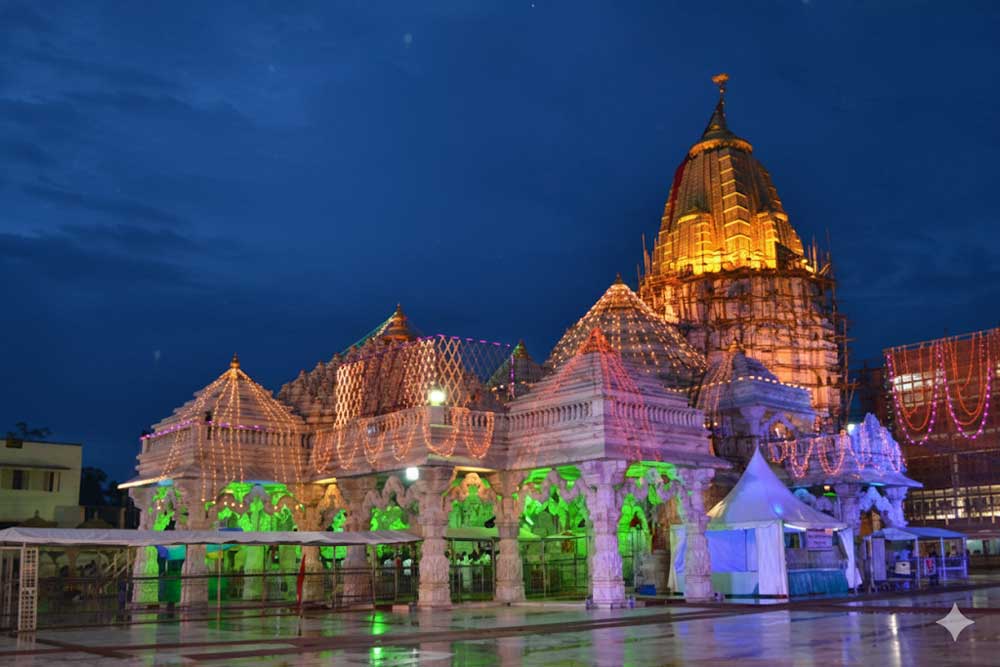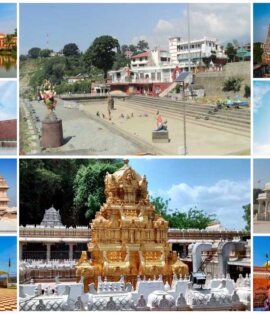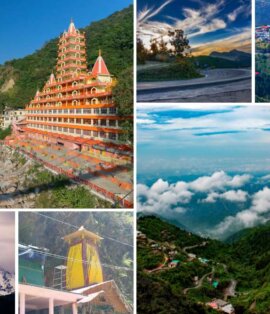Ambaji Temple is in the tranquil Aravalli Hills of Banaskantha, Gujarat. It is one of India’s key pilgrimage sites. Dedicated to Goddess Amba and listed as one of the 51 Shakti Peeths, it is believed to mark the spot where Goddess Sati’s heart fell. Unlike other temples, Ambaji has no idol. Instead, it displays the sacred Shri Visa Yantra, symbolizing the goddess’s presence.
As you approach Ambaji, the gentle rustle of leaves in the Aravalli Hills greets you, accompanied by the soft ring of temple bells that seem to resonate with the heartbeats of those present. The air is rich with the aroma of incense, blending with the warm desert breeze, creating a vibrant atmosphere that sets the stage for exploring Ambaji’s spiritual significance and unique traditions. Visitors are invited to discover why the temple holds a special place in the hearts of devotees.
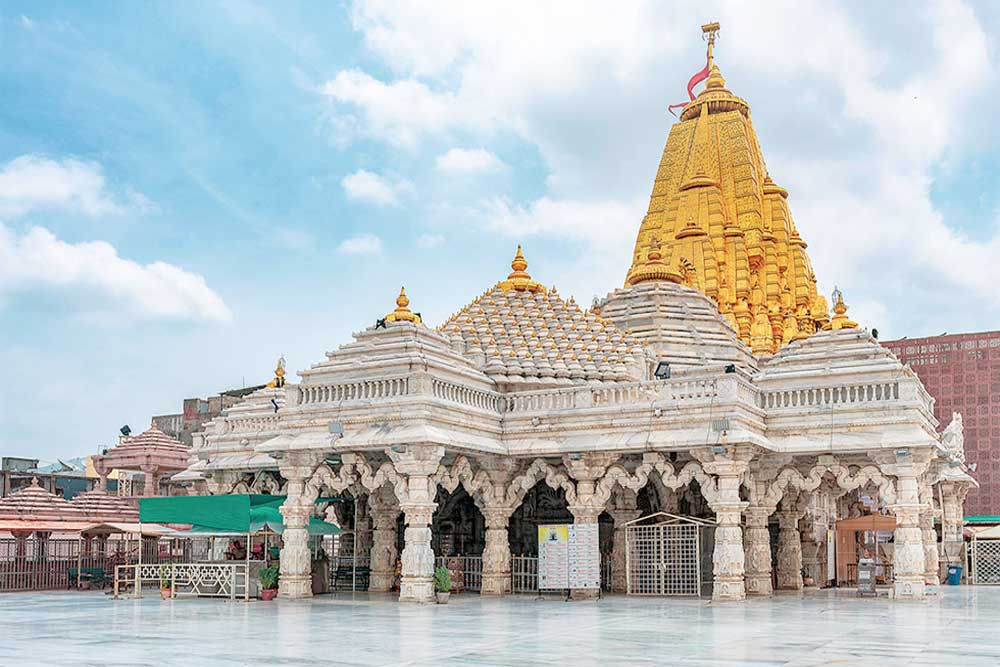
Spiritual Significance of Ambaji Mandir
Ambaji Temple holds great spiritual significance as one of the Shakti Peeths in India. These centers of divine power are where devotees seek blessings, and Ambaji is believed to be especially powerful. The legend of Shakti Peeths is deeply rooted in the Indian religious landscape, as these sites are considered to map the sacred geography of the country. Each Shakti Peeth, including Ambaji, embodies a unique spiritual narrative that draws pilgrims from all over India, adding layers to their journey along these mystical routes.
As a Shakti Peetha, Ambaji attracts worshippers of the Goddess Durga in her various forms. Many visit to connect with the divine feminine energy. Along with Ambaji, Pavagadh Temple is also revered as a Shakti Peeth in Gujarat, attracting countless devotees seeking the blessings of Goddess Shakti.
Other Shakti Peethas
Ambaji Temple Darshan and Aarti Timings
The schedule for darshan and aarti at Ambaji Temple is structured to accommodate the influx of pilgrims throughout the day. If you are planning your visit, here is a detailed timing schedule to help you:
- Morning Aarti: 7:30 AM to 8:00 AM
- Morning Darshan: 8:00 AM to 11:30 AM
- Afternoon Break: 12:00 AM to 12:30 PM
- Afternoon Darshan: 12:30 PM to 4:15 PM
- Evening Aarti: 6:30 PM to 7:00 PM
- Evening Darshan: 7:00 PM to 9:00 PM
Visitors can attend the artis and darshan at these convenient times.
Gabbar Hill: The Original Abode of Goddess Amba

Gabbar Hill is 4 kilometers from the main Ambaji Temple. It is the original home of Goddess Amba, and local tradition holds that her heart is said to have fallen here. Many pilgrims climb Gabbar Hill, finding the journey challenging and spiritually uplifting.
Climbing Gabbar Hill is a key spiritual experience. The hike is challenging, offers great views, and brings devotees closer to the divine.
Ambaji is one of the 51 Shakti Peeths in Gujarat and holds a special place in the Shakti tradition of Hinduism. These sites are sacred for worshiping the divine feminine energy. Each mark is where a part of Goddess Sati fell. Ambaji is linked to her heart.
The spiritual energy of Ambaji Temple attracts devotees who connect with the divine feminine through prayers, offerings, and rituals. Unlike most temples, Ambaji follows the tradition of worshipping the Visha Yantra instead of an idol, with this sacred symbol embodying the goddess’s presence. Devotees believe the Yantra grants their prayers and fulfills their desires.
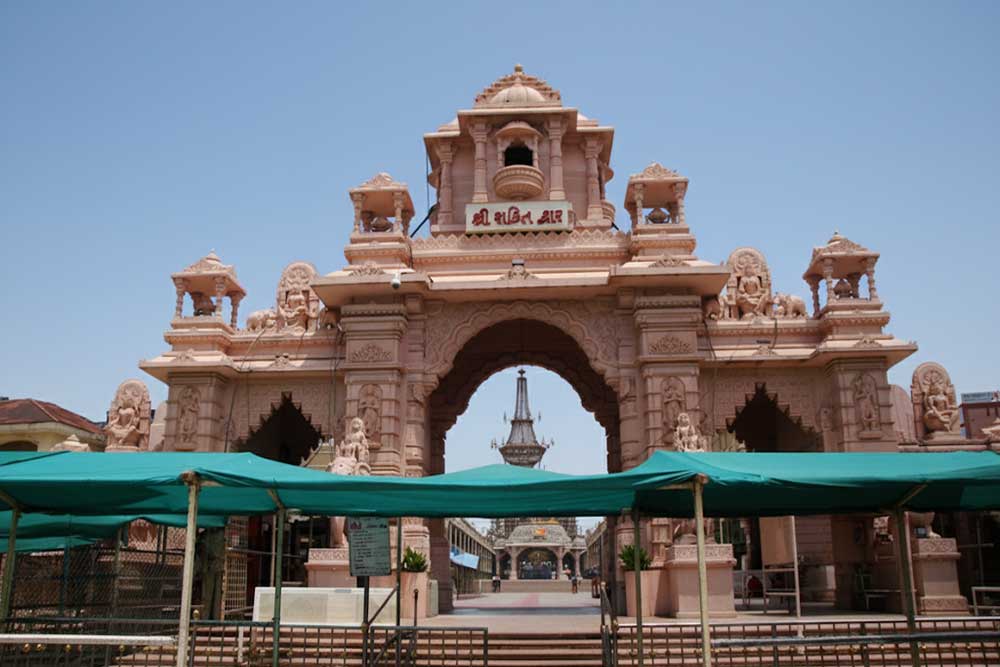
How to Reach Ambaji Temple
By Road
Ambaji is well-connected by road to major cities in Gujarat and Rajasthan. It is about 185 kilometers from Ahmedabad, making it accessible for devotees traveling by car or bus. From Palanpur, about 65 km away, there are frequent buses to Ambaji. Abu Road is just 20 km away.
By Rail
The nearest major railway station is Abu Road, about 20 kilometers from Ambaji Temple. Abu Road connects to major cities such as Delhi, Mumbai, and Jaipur. Taxis and auto-rickshaws provide transport from the station to the temple.
By Air
Fly to Sardar Vallabhbhai Patel International Airport in Ahmedabad, about 180 km from Ambaji. Take a taxi from the airport to the temple.
The main shrine, Shri Arasuri Ambaji Mata Devasthan, stands at the foot of Gabbar Hill and is dedicated to Goddess Amba. The temple’s design is simple and features the sacred Shri Visa Yantra instead of an idol. Worshippers believe the Yantra brings blessings of health, prosperity, and spiritual growth. The peaceful setting encourages prayer and reflection.
Bhadarvi Poonam Fair: A Vibrant Celebration
The Bhadarvi Poonam Fair is a significant event held at the Ambaji Temple. It takes place each year on the full moon night in Bhadarvo (August-September). Millions of pilgrims attend, making it one of Gujarat’s largest religious gatherings. The temple is illuminated, and devotees participate in cultural activities, including Garba and Bhavai dances.
The Bhadarvi Poonam Fair is a time for communal prayer and spiritual unity. Large crowds come to offer prayers to Goddess Amba. The fair also celebrates the region’s rich cultural traditions with performances, exhibitions, and local crafts.
Hotels and Accommodation Near Ambaji Temple
Pilgrims find several hotels and guesthouses near Ambaji. Options include:
- Hotel Amba Heritage: Located near the temple. This hotel offers comfortable rooms and a serene atmosphere for its guests.
- Shree Hotel: This is a family-friendly hotel. It offers modern amenities and easy access to the temple and surrounding attractions.
- Pride Resort Ambaji: This is a luxury resort with premium facilities. It is perfect for those seeking a more luxurious stay.
These hotels provide excellent facilities and are ideal for devotees visiting Ambaji for worship and spiritual rejuvenation.
Conclusion
Ambaji Temple is a place of deep spiritual significance, not only for its association with the 51 Shakti Peeths, but also because it is one of the rare temples in India where the goddess is worshipped without an idol, solely through the revered holy symbol, the Shri Vishnu Yantra. Whether you visit for a brief darshan or a more extended spiritual journey, the hill offers a sacred and peaceful environment to connect with the divine. The temple’s rich history, spiritual significance, and cultural vibrancy make it a must-visit destination for pilgrims and tourists alike.

